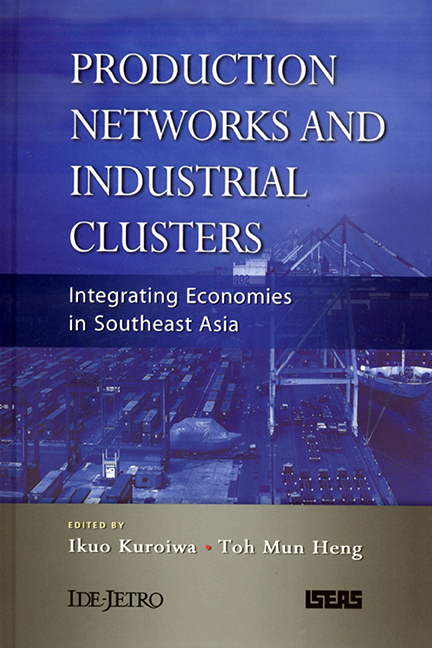Book contents
- Frontmatter
- Contents
- List of Tables
- List of Figures
- Preface
- Acknowledgements
- Contributors
- 1 Introduction
- I Overview of the Production Networks and Industrial Clusters in Southeast Asia
- II Case Studies
- III Drivers for the Expanding Production Networks
- 8 Supply Chain Management and Logistics in Southeast Asia
- 9 Regional Economic Cooperation and Production Networks in Southeast Asia
- 10 Concluding Remarks: Implications for Public Policy
- Index
9 - Regional Economic Cooperation and Production Networks in Southeast Asia
from III - Drivers for the Expanding Production Networks
Published online by Cambridge University Press: 21 October 2015
- Frontmatter
- Contents
- List of Tables
- List of Figures
- Preface
- Acknowledgements
- Contributors
- 1 Introduction
- I Overview of the Production Networks and Industrial Clusters in Southeast Asia
- II Case Studies
- III Drivers for the Expanding Production Networks
- 8 Supply Chain Management and Logistics in Southeast Asia
- 9 Regional Economic Cooperation and Production Networks in Southeast Asia
- 10 Concluding Remarks: Implications for Public Policy
- Index
Summary
INTRODUCTION
Prior to the Asian financial crisis in 1997, rapid and dynamic economic growth in Southeast Asia was facilitated through market-driven forces. Various regional economic cooperation initiatives and schemes were introduced, including an agreement on ASEAN Free Trade Area (AFTA) in 1992 which came into full operation by end of 2003. However, the net impact of ASEANinitiated regional cooperation was negligible because ASEAN economies were basically competing on the same product range and their main export markets were to non-ASEAN members, that is, the United States, European Union and other developed economies. It is often said that ASEAN as a regional organization is more effective in “pooling resources” rather than in “sharing market”. As a result of this structural economic and political reality, it is not so much the regional governments that have been driving regional economic integration but globalization process and transnational corporations supported by complementing rules and regulations instituted and implemented domestically and regionally by ASEAN countries.
The economic collapse of many Southeast Asian economies after the Asian financial crisis paved the way for the establishment of ASEAN+3 (China, Japan and South Korea) framework or regional economic cooperation. Underlying this fundamental change in regional approach for economic integration is the emerging elements of the rise of China and India, weakening of multilateral trading system and structural imbalances in ASEAN economies weakened by the financial and economic crisis in 1997. It seems without a closer and strengthened economic integration with Northeast Asian economies, ASEAN economies would experience prolonged structural disequilibrium to restore their economic dynamism. Because of the absence of a framework of cooperation in Northeast Asia, specifically because of the bilateral relations between China and Japan, ASEAN has become the defaulted “hub” of East Asia economic integration.
Regional economic integration in de-facto sense has been accelerating. The share of intra-East Asia trade has been estimated at around 58 per cent by end of 2005 which was higher than intra-regional trade in western hemisphere and almost equaling with European Union (EU).
However, economic integration in East Asia does not seem to develop in an even manner since it has been mainly market-driven. The intraregional trade pattern seems to suggest that economic activity needs a large space in which to expand.
- Type
- Chapter
- Information
- Production Networks and Industrial ClustersIntegrating Economies in Southeast Asia, pp. 301 - 334Publisher: ISEAS–Yusof Ishak InstitutePrint publication year: 2008



